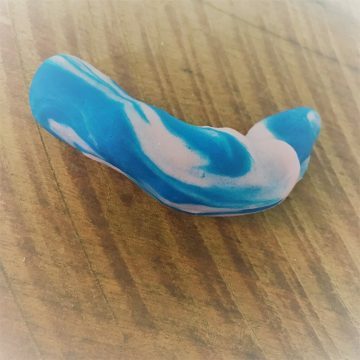
Table of Contents
Here are 4 reasons to let them mix the play dough. I thought everyone was already cool with this. Still, a friend recently shared a social media post that showed how many parents and caregivers are viscerally shaken at the idea of children mixing play dough colors. Some comments mentioned the stress and anxiety color mixing caused. Some called it wrong. Some tried to prevent it. Others bit their lip, felt their skin crawl, and let them mix the play dough.

Others, of course, were happy to let it happen and even took steps to support and encourage the mixing.
I’m not here to judge anyone. We all have different temperaments, tolerances, and things that get under our skin to scratch our nerve endings. For example, I start twitching when someone puts ketchup on a steak. I’m also very comfortable speaking in front of large crowds, but get uncomfortable and self-conscious chatting one-on-one with the cashier at the grocery store. We are who we are.
What I am here to do is defend the developmental benefits that emerge when you let them mix the play dough.
No matter where you fall on the Play-Dough-Color-Mixing Spectrum, there are reasons to at least think about letting them mix the play dough. Let’s take a quick look at four of them.
It’s Fun
The first of our 4 reasons to let them mix the play dough is that it’s fun. Maybe not for you, but for the kids who enjoy it, squishing and squashing a solid ball of Blue and A solid ball of Yellow into a giant ball of Green is a blast. I’ve seen the eyeballs of small children grow wide with amazement as the two colors swirl into one.

There’s much to be said about the value of simple fun in our rushed world. It reduces stress, refreshes the mind, and it creates calm. Plus, kids who are having fun stay engaged longer. Kids who stick with an activity longer learn more from it. They also build their ability to focus. An additional benefit for any nearby adults is that you can relish the peace and quiet while kids are happily engaged in an activity they enjoy.
It Helps Prepare Little Hands For Writing
The second reason to let them mix the play dough is that it makes little hands stronger and more nimble. All the repetitive squishing and squashing required to incorporate colors builds muscle strength and control. There are a lot of muscles at work in such mixing: 34 muscles controlling the fingers and thumb, 17 in the palm, and another 18 in the forearm. For a young child to hold a pencil and write their name, they must first gain control of those 69 muscles. Knowing how tightly to grip the pencil, how much pressure to apply when bringing the pencil into contact with the paper, and making the pencil tip dance across the page to create the squiggles that spell C A T, P U R P L E, and all the other words they could potentially write is not possible without lots of opportunities to build the required physical skills.
It Helps Prepare Little Eyes For Reading and Writing
Reason 3 to let them mix the play dough is because it’s good for their eyes. Dough mixing is also a great way to build visual skills necessary for reading and writing. Making colors transform helps kids develop visual tracking skills and hand-eye coordination. It also helps them differentiate between positive and negative space. A child must distinguish between the page’s background and the writing to read or write. They need to be able to track from one word to the next. They need to process all the information their eyes take in. Building those skills takes a lot of practice, and dough mixing helps.
It Hones Investigative Skills
The last of our reasons for letting them mix the play dough is that it prompts investigation. One of the questions young children consistently try to answer for themselves is, “What’s going on here?” They are always hard at work trying to figure out how the world works. Dough mixing is a chance to investigate, a chance to figure something out, an opportunity to explore. As an adult, you know that mixing all the vibrant colors results in some shade of dull brown. Kids only learn this critical information about the world from experimentation and repetition. Their investigative skills don’t strictly follow the scientific method, but they do amazingly well at figuring things out and making discoveries when given a chance. Dough mixing is a STEM activity; it’s a chance for kids to ask “What if…” and then follow up with an experiment.

Wait, There’s More
Depending on the situation, dough mixing may also be a conduit to other learning. For example, if a group of children is dough mixing, they will practice social and language skills. If they can take off their shoes and mix the dough with their toes, they’ll build strength and control of different muscles. If they’re allowed to add a squirt or two of paint to their dough, it becomes a whole new experiment.
4 Reasons To Let Them Mix The Play Dough Wrap Up
Banning color mixing is one way to go if you, as the adult in the room, can’t stand it. Kids are incredibly resilient; they will probably grow into fully functioning adults if they never get to mix the colors. On the other hand, why not let them mix the play dough? There’s a lot for kids to learn while mixing play dough colors, so setting aside your discomfort and letting it happen has plenty of upsides.
Here are some related DIY ideas if you decide to let them mix the play dough:
As always, your thoughts and ideas are welcome in the comments.
Brought to you by Explorations Early Learning
Contribute content to Playvolution HQ
Browse Trainings
Post Author
Jeff Johnson is an early learning trainer, podcaster, and author who founded Explorations Early Learning, Playvolution HQ, and Play Haven.








Leave a Reply